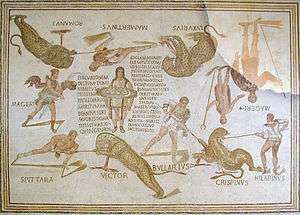Magerius Mosaic
The Magerius Mosaic is a 3rd-century Roman mosaic discovered in 1966 in the Tunisian village of Smirat and presently displayed in the Sousse Archaeological Museum.[1] The mosaic presumably decorated a country villa belonging to a man named Magerius.[1]

At the centre of the mosaic a steward is shown with four moneybags on a tray. Each moneybag symbolises a thousand denarii. The steward is surrounded by four named leopards, being speared by four named hunters. The mosaic presents a very rare evidence of the actual sums paid for animals used in the amphitheatre spectacles.[1] Two of the three other figures on the mosaic are presumably deities, despite the adjacent Latin inscription Mageri.[1] A figure striding forward on the left is usually identified as the goddess Diana.[1] Another figure, with a saucer-shaped object in his right hand, and a staff in his left, is usually identified as Bacchus or Liber Pater.[1]
Amphitheatre venatio shows were often depicted in villa mosaics.
References
- "The Magerius Mosaic". Current Archaeology. October 3, 2007. Retrieved June 15, 2015.